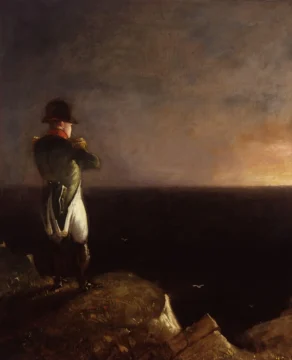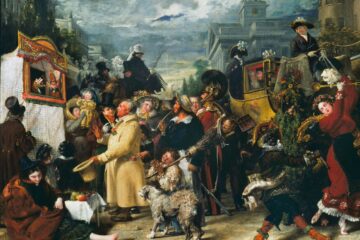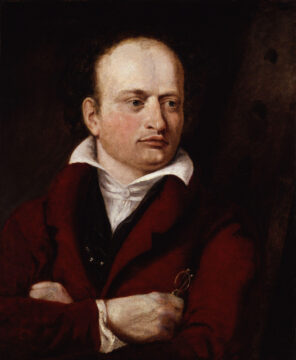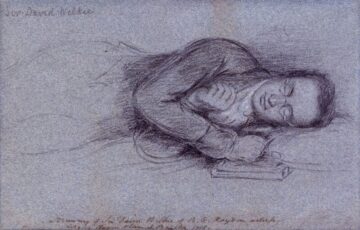by Steve Szilagyi

June 1846 was the hottest month ever recorded in London at that time. For 22 sweltering days, temperatures soared between the 85 and 105 degrees Fahrenheit. The city’s literary luminaries—Elizabeth Barrett, Robert Browning, Alfred Lord Tennyson, and Thomas Carlyle among them—mopped their brows and grumbled about the oppressive heat like common mortals. Meanwhile, down in Piccadilly, sweating crowds lined up by the thousands outside Egyptian Hall. They had come to see P.T. Barnum’s latest sensation, the celebrated little person Tom Thumb. Barnum’s show was the talk of the town—that is, until June 22, when the heat and gossip took a backseat to shocking news. Benjamin Robert Haydon, a painter, writer, and lecturer known to them all, had been found dead in his studio, the victim of his own tragic hand.
Haydon was an extraordinary figure—brilliant, ambitious, and doomed. His life was a tale of grand aspirations, bad luck, and worse decisions. Stricken by a mysterious illness at age six, he suffered bouts of blindness for much of his life. Nonetheless, he pursued the vocation of art with fanatical zeal. Unlike many of his contemporaries who earned comfortable livings painting portraits or landscapes, Haydon devoted himself to “historical painting,” creating enormous canvases that depicted grand scenes from history and the Bible. These were not modest works; 10 by 15 feet was a typical size. But despite his herculean efforts, he rarely sold these massive paintings. The problem? They were too big to hang anywhere—and, by general consensus, they weren’t very good.
Yet Haydon’s story endures because of his remarkable personality and relentless pursuit of a hopeless dream. He inspired at least two excellent modern books: Paul O’Keeffe’s magisterial biography, A Genius for Failure, and Althea Hayter’s A Sultry Month: Scenes of London Literary Life in 1846. Haydon fascinates not because he was a great painter—he wasn’t—but because of his peculiar idealism, boundless energy, and talent for making all the wrong enemies.

Driven by the bees in his bonnet. From early on, Haydon was a man driven by a buzzing hive of what even his contemporaries called “bees in his bonnet.” Chief among them was the belief that Great Britain could and should rival continental powers like France and Italy in the fine arts. After Napoleon’s defeat, when Britain was the world’s dominant power, Haydon was galled that his country lagged behind in fame of its painting. He tirelessly lobbied the government and aristocracy to fund an infrastructure of art schools and galleries, convinced that this would elevate British art to its rightful place. His preferred vehicle for this national greatness? Massive historical paintings—which, naturally, he believed he was the ideal man to create.
The problem was, Haydon wasn’t a very good painter. His work was often flabby, stiflingly conventional, and awkwardly posed. The figures were sometimes out of proportion, with large upper bodies and small legs—a defect attributed to his poor eyesight and the fact that he couldn’t afford a studio large enough to step back and view his paintings as a whole. Yet what he lacked in talent, he made up for in sheer audacity. He repeatedly borrowed money to finance his giant canvases, then exhibited them in rented halls, charging the public admission to see them. The size alone made them a spectacle.
A hated greatest hit. This pattern defined much of Haydon’s life. He used his considerable powers of persuasion to create a market for his work, winning a few patrons and admirers along the way. But payment was often delayed or disputed, and his debts mounted. He married and started a family, but his finances spiraled out of control, landing him in debtors’ prison more than once. Haydon scorned portraiture and small paintings, yet ironically, it was in these scaled-down works that he found his few moments of commercial success. His painting Napoleon Musing at St. Helena, a modest 5X8-foot canvas showing the exiled emperor gazing out over the ocean, became surprisingly popular. He painted multiple versions, adding Wellington Contemplating the Field of Waterloo to his repertoire. With every iteration, the Napoleons are more carelessly painted. You can tell he probably came to hate them, like a rock band forced to play its one greatest hit again and again.

Heroes with a single face. Haydon had a tendency to work and rework the faces of his most central figures (Jesus, Solomon, Alexander the Great) and then, in the end, stamp them with his own distinctive features. This peculiarity of consciously or unconsciously making himself the hero in his own paintings can be seen most obviously in Curtius Leaping into the Gulf (shown at the top of this article). The image is a very cool one in its weird way and is based on the Roman legend of Marcus Curtius, who is said to have saved the city by plunging, horse and all, into a vast abyss that had suddenly opened in the Forum. Haydon no doubt identified with Curtius, as he repeatedly fell into the abyss of scorn and penury for the sake of art with a capital A.

Punch or May Day. But the real gems of Haydon’s career were four lively and comparatively small (5X8 foot) paintings: Punch or May Day, Bartholomew Fair, The Mock Election, and Chairing the Member. These bustling scenes of Victorian street life, filled with vividly drawn characters of all ages and classes, reveal a different side of Haydon—fresh, energetic, and full of life. Punch or May Day, the best of the lot, shows a lively crowd gathered around a Punch and Judy show outside St. Marylebone Church. It’s a delightful cross-section of society, with lightly suggested narratives and symbolism. In these works, Haydon looks back at the rowdy 18th century crowds of Thomas Rowlandson, and anticipates the popular Victorian street scenes of William Powell Frith and the Pre-Raphaelites. You can’t help but thinking if he’d hung on in this style, he’d be a beloved icon of British art, standing only slightly below his contemporaries J.M.W. Turner and John Constable.
Unfortunately, these pictures didn’t sell any better than his historical works. Discouraged, Haydon abandoned this promising style (he didn’t like it anyway) and returned to his old ways—big, bloated canvases that nobody wanted.

“Judaically obstinate”. Haydon’s life was a series of battles—with critics, with the Royal Academy, and, most of all, with himself. His own son described him as “Judaically obstinate” and constantly involved in “broils”. Haydon’s feud with the Royal Academy began early in his career, when he took offense at how one of his paintings was exhibited in its annual show. He spent the rest of his life loudly criticizing the institution and secretly wishing that they’d forgive him and elect him a member.
Although could be abrasive and opinionated, he was certainly possessed of a certain charisma, for he was not without devoted friends and admirers. As a merry young bohemian, he kept company with the likes of Leigh Hunt, William Hazlitt, and Percy Bysshe Shelly. Poet William Wordsworth was a lifelong supporter who once wrote a sonnet in his honor. (Haydon’s thoughtful portrait of Wordsworth is one his better works.)
Like Samuel Johnson (whom he revered) Haydon was a pious sinner (prostitutes, drink, stiffing creditors), and wrote prayers begging for help in overcoming what he believed was his own laziness. His smart friends trolled him about his religiosity, and he once stormed out of a party in anger over jibes from Hazlitt.
Some of Haydon’s short-term failures were long term successes. His lobbying efforts made him a pest to government officials, but in the long run, they helped move opinion toward the establishment of Britain’s National Gallery. He was an early promoter of a better home for the Elgin Marbles, sketching them when they were still piled in a shed in Lord Elgin’s back yard. Passionate about art education, he lectured widely on painting, design and public access to the arts (his talks were collected and sold well). On lecture tours to places like Liverpool and Manchester, he was treated like a big-time artist and celebrity long after he’d fallen off London’s social radar.
Tom Thumb Blues. In the hot summer of 1846, Haydon was in his usual desperate financial straits. Having pawned everything he could, he resorted to his old expedient of putting on a show of his enormous historical paintings. He rented rooms in a place called Egyptian Hall, an all-purpose showplace on Piccadilly Street. He hadn’t counted on P.T. Barnum renting space in the same building for his Tom Thumb extravaganza. While Haydon’s exhibit drew a mere 133 and 1/2 paying visitors (the half being a small child), Barnum’s show attracted over 15,000. Charles Dickens, who attended both exhibitions, described seeing Haydon standing alone and dejected in his empty gallery while mobs streamed past to see Tom Thumb. It was, Dickens observed, profoundly melancholy.
Haydon closed the show early, and took out a notice in the newspaper making light of his failure. Back at his studio, however, he sat for three hours, staring at his unfinished painting, The Blessings of Justice, in an “idiot” stupor. On June 22, he took a walk with his son, and later, on his own, stopped in at gunsmith’s a bought a small pistol. Returning to his studio, he stood before the big painting and shot himself in the head. The bullet was too small to penetrate the skull, so Haydon grabbed a knife and applied it to his throat with two great slashes. This time, he succeeded. Blood is said to have spattered the surface of The Blessings of Justice, his final work.
See them at Tate Britain. Haydon’s death shocked his friends and acquaintances. Althea Hayter’s A Sultry Month vividly reconstructs the aftermath, showing how figures like Elizabeth Barrett, and Jane and Thomas Carlyle reacted to the tragic news. In the wake of Haydon’s suicide, Dickens delivered this this cruel summation: “All his life [Haydon] had utterly mistaken his vocation. No amount of sympathy with him and sorrow for him in his manly pursuit of a wrong idea for so many years – until, by dint of his perseverance and courage it almost began to seem a right one – ought to prevent one from saying that he most unquestionably was a very bad painter, and that his pictures could not be expected to sell or to succeed.”
Married to a younger widow, to whom he was devoted, Haydon had ten children, seven of whom died in infancy or as children. He prayed that his two sons would not inherit his passion for painting, believing that any fate, however horrible, was preferable to the kind of suffering he’d endured in pursuit of the art. His prayer was answered. One of his sons became a composer, the other a civil servant. Yet they did seem to have inherited something from the father, as both also died by suicide.
In the years since his death, Haydon’s reputation has remained mixed. His massive historical paintings are mostly forgotten, but Punch or May Day and Chairing the Member hang proudly in Tate Britain, where they continue to delight viewers. Haydon should also be remembered for his posthumously published Autobiography. Based on his journals, it’s lively, superbly written, and full of insights into the literary and political life of Victorian London. (Dickens’ dislike of Haydon might have sprung from his discomfort at his potentially being a near rival.)
Looking at Punch or May Day, you can’t help but wonder what might have been. Why didn’t Haydon do more of these zestful snapshots of the life around him. Why didn’t he paint the streets he knew and the era he lived in? It’s a question we’ll never answer. But for all his flaws and failures, Benjamin Haydon remains a fascinating figure—part genius, part ass, and wholly unforgettable.

